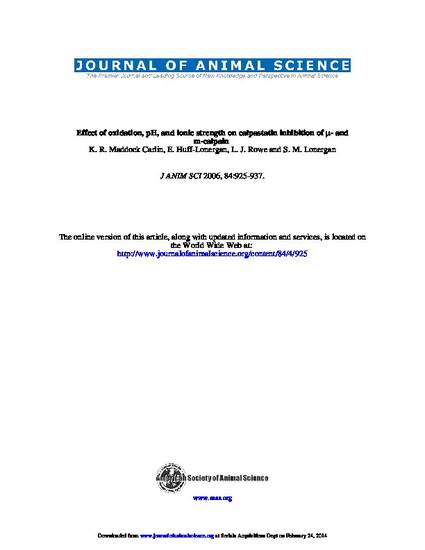
The objective of this study was to evaluate the effect of oxidation on μ- and m-calpain activity at varying pH and ionic strength conditions in the presence of calpastatin. In 2 separate experiments, purified porcine skeletal muscle μ- or m-calpain (0.45 units of caseinolytic activity) was incubated in the presence of calpastatin (0, 0.15, or 0.30 units) at pH 7.5, 6.5, or 6.0 with either 165 or 295 mM NaCl. The reactions were initiated with the addition of CaCl2 (100 μM for μ-calpain; 1 mM for m-calpain). In Experiment 1, μ- or m-calpain was incubated with the calpain substrate Suc-Leu-Leu-Val-Tyr-AMC (170 μM). Either 0 or 16 μ μM H2O2 was added to each assay. Activity was measured at 60 min. In Experiment 2, calpain was incubated with highly purified porcine myofibrils (4 mg/mL) under conditions described. Either 0 or 100 μM H2O2 was added immediately prior to the addition of calpain. Degradation of desmin was determined on samples collected at 2, 15, 60, and 120 min. Results from Experiment 1 indicated that oxidation decreased (P < 0.01) activity of μ-calpain. μ-Calpain had the greatest (P < 0.01) activity at pH 6.5, and m-calpain had the greatest (P < 0.01) activity at pH 7.5 at 60 min. m-Calpain activity was not detected at pH 6.0. μ- and m-calpain activity were lower (P < 0.01) at 295 mM NaCl than at 165 mM NaCl at all pH conditions. Oxidation lowered (P < 0.01) calpastatin inhibition of μ-and m-calpain at all pH and ionic strength combinations. In Experiment 2, oxidation decreased proteolytic activity of μ-calpain against desmin at pH 6.0 (P < 0.05 at 15, 60, and 120 min) and decreased m-calpain at all pH conditions. However, desmin degradation by μ-calpain was not as efficiently inhibited by calpastatin at pH 7.5 and as at pH 6.5 (P = 0.03 at 60 min) when oxidizing conditions were created. This is consistent with the results from Experiment 1, which indicated that oxidation decreased the ability of calpastatin to inhibit μ-calpain. These studies provide evidence that oxidation influences calpain activity and inhibition of calpains by calpastatin differently under varying environmental conditions. The results suggest that, at the higher pH conditions used, calpastatin may limit the possibility of oxidation-induced inactivation of μ-calpain.
Available at: http://works.bepress.com/elisabeth_huff-lonergan/1/

This article is from Journal of Animal Science 84 (2006): 925–937. Posted with permission.